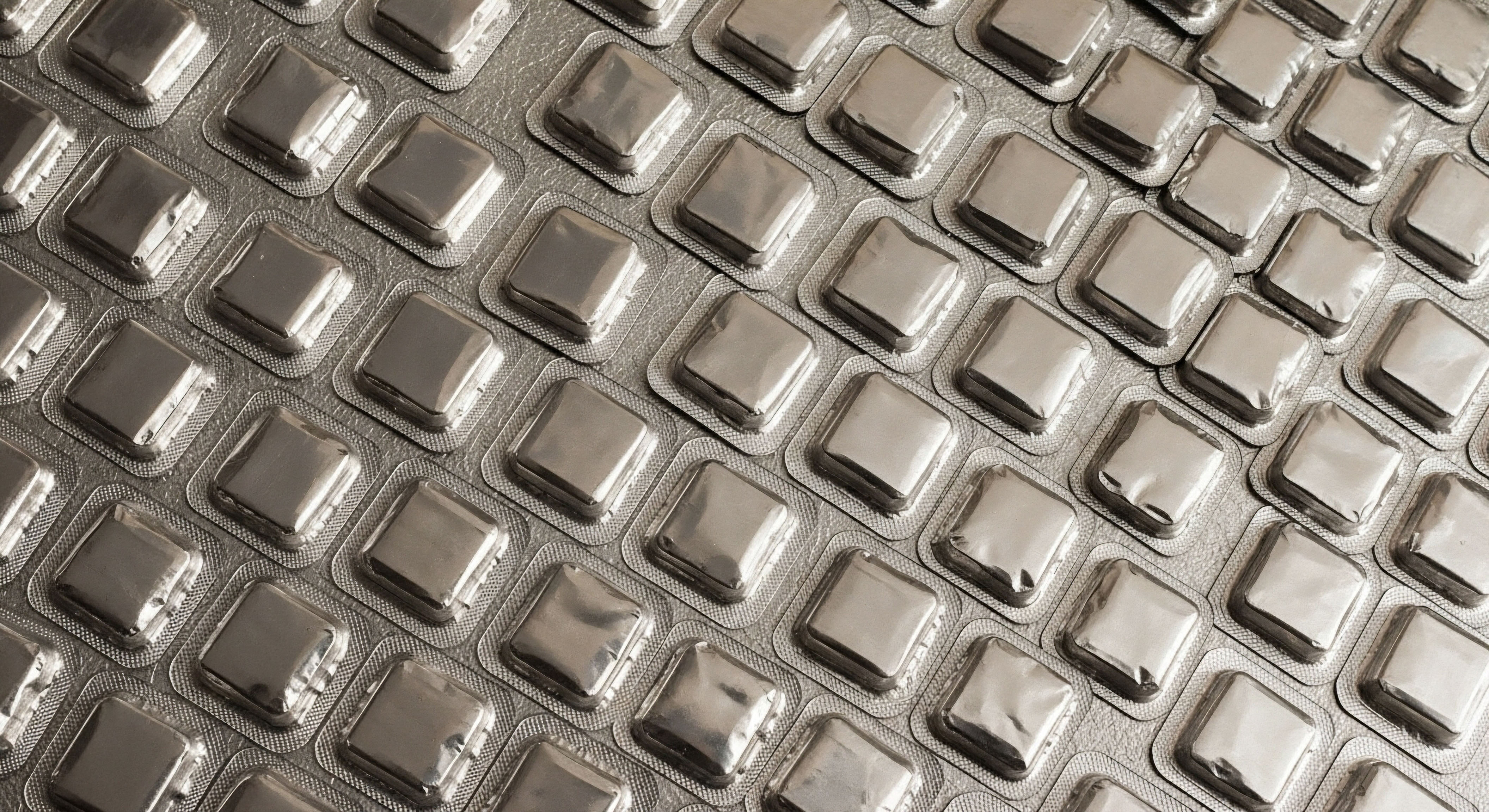

Fundamentals
You may be feeling a persistent sense of fatigue, a subtle but unshakeable disconnect from the vitality you once knew. Perhaps you are grappling with changes in your mood, your body composition, or your overall sense of well-being, and suspect your hormones are at the center of this internal shift.
This experience is a common starting point for a journey into understanding your own biology. The question of whether something as seemingly simple as sleep can influence complex hormonal therapies is a deeply personal and valid one. It speaks to a desire to reclaim control over your body’s intricate systems.
Your body operates on an internal, 24-hour clock known as the circadian rhythm. This is the master conductor of your biological orchestra, governing thousands of processes, from your body temperature to your digestive function. The most profound and influential of these processes is the release of hormones.
Your endocrine system, the network of glands that produces these powerful chemical messengers, is exquisitely sensitive to the cues of this rhythm. Sleep is the primary activity that calibrates and synchronizes this entire network. When sleep is consistent and restorative, the hormonal symphony plays in tune. When it is disrupted, the entire system can fall into disarray.
The endocrine system’s function is deeply intertwined with the daily sleep-wake cycle, making sleep a foundational pillar of hormonal health.

The Nightly Recalibration of Your Hormonal Axis
Think of your endocrine system as a series of conversations happening between your brain and various glands throughout your body. The brain, specifically the hypothalamus and pituitary gland, sends out signals that instruct other glands, like the adrenals, thyroid, and gonads (testes or ovaries), when to release their hormones.
This communication network is known as a hormonal axis, such as the Hypothalamic-Pituitary-Adrenal (HPA) axis which governs your stress response, or the Hypothalamic-Pituitary-Gonadal (HPG) axis which manages reproductive hormones.
Sleep is the time when these conversations are most coherent and productive. During the deep, restorative stages of sleep, your body performs critical maintenance on these systems. For instance:
- Growth Hormone (GH) ∞ The vast majority of this vital hormone, essential for tissue repair, cellular regeneration, and maintaining healthy body composition, is released in a large pulse during the first few hours of deep sleep.
- Cortisol ∞ This primary stress hormone naturally reaches its lowest point during the initial phases of sleep, allowing your body to enter a state of repair. Its levels then begin to rise in the early morning hours to prepare you for waking. Chronic sleep loss disrupts this pattern, often leading to elevated cortisol levels in the evening, which can interfere with sleep and promote metabolic dysfunction.
- Testosterone ∞ In men, testosterone production is closely linked to sleep duration and quality. Levels naturally rise during the night and peak in the morning. Consistent sleep restriction has been shown to significantly reduce daytime testosterone levels, contributing to symptoms like low energy and reduced libido.
- Estrogen and Progesterone ∞ In women, the intricate dance between these two hormones is influenced by sleep quality across the menstrual cycle. Sleep disturbances, which are common during perimenopause and menopause, can exacerbate the symptoms associated with these hormonal shifts.
When you begin a hormonal therapy, such as Testosterone Replacement Therapy (TRT) or bioidentical hormone support for menopause, the goal is to restore balance to a system that is struggling. These protocols introduce external hormones to supplement what your body is no longer adequately producing. A foundational understanding reveals that by optimizing the very process that naturally governs your hormonal state ∞ sleep ∞ you may be able to create a more receptive and efficient internal environment for these therapies to work.


Intermediate
Moving beyond the foundational connection between sleep and hormones, we can examine the precise mechanisms through which personalized sleep strategies can influence the efficacy of hormonal optimization protocols. When a clinician prescribes a therapy like TRT for a man experiencing symptoms of andropause, or a combination of testosterone and progesterone for a woman in perimenopause, the objective is to re-establish a physiological hormonal environment.
The dosage is carefully calculated to alleviate symptoms and bring biomarkers into a healthy range. The body’s own sensitivity to these hormones, however, is a dynamic variable. This is where sleep becomes a powerful modulator.
A state of chronic sleep debt induces a low-grade, systemic inflammatory state and heightens stress signaling through the HPA axis. This environment can create a form of hormone resistance, where the receptors on your cells become less responsive to the hormones circulating in your bloodstream, whether they are produced endogenously or administered therapeutically.
Consequently, a higher dose of a given hormone might be required to achieve the desired clinical effect in a poorly-rested individual compared to someone with a robust sleep architecture.
Optimizing sleep architecture can enhance cellular sensitivity to hormonal signals, potentially allowing for lower therapeutic doses.

How Does Sleep Architecture Impact Specific Hormonal Therapies?
Sleep is not a monolithic state. It is composed of several cycles of different stages, primarily Non-REM (which includes light and deep slow-wave sleep) and REM (Rapid Eye Movement) sleep. Each stage has a distinct neurophysiological signature and serves different restorative functions, many of which are directly tied to the endocrine system.

The Role of Slow-Wave Sleep in Anabolic Hormone Release
Deep sleep, or slow-wave sleep (SWS), is the phase most critical for physical restoration. It is during this time that the pituitary gland is maximally stimulated to release Growth Hormone (GH). This is particularly relevant for individuals on therapies designed to boost GH levels, such as those using peptides like Sermorelin or the combination of Ipamorelin and CJC-1295.
- Sermorelin and Ipamorelin/CJC-1295 ∞ These are known as growth hormone secretagogues. They work by stimulating the pituitary gland to produce more of your own GH. Since the body’s natural, largest pulse of GH occurs during SWS, strategies that specifically increase the duration and quality of deep sleep can create a more powerful synergistic effect with these peptides. A person with optimized SWS may experience a more robust response to a standard dose of these peptides compared to someone with fragmented sleep and minimal SWS.
- MK-677 (Ibutamoren) ∞ This oral secretagogue also enhances GH and IGF-1 levels and is known to increase the duration of SWS. A personalized sleep plan that supports this natural deep sleep window can amplify the restorative benefits of the compound.
By focusing on strategies that promote SWS ∞ such as maintaining a consistent sleep schedule, managing evening light exposure, and ensuring a cool sleep environment ∞ an individual can enhance the very biological pathway these therapies are designed to target.

Sleep, Cortisol, and Testosterone Regulation
The interplay between cortisol and testosterone provides a clear example of how sleep can influence dosage requirements for TRT. Sleep restriction is a potent stressor that elevates cortisol. Chronically high cortisol can suppress the function of the HPG axis, which controls testosterone production. For a man on TRT, elevated cortisol can work against the therapy by increasing the activity of aromatase, the enzyme that converts testosterone into estrogen, and by generally promoting a catabolic (breakdown) state in the body.
A personalized sleep protocol that successfully lowers evening cortisol and ensures adequate sleep duration can help restore a more favorable testosterone-to-cortisol ratio. This improved internal biochemical environment may mean that a lower dose of injectable Testosterone Cypionate is needed to achieve the desired clinical outcomes, such as improved energy, libido, and body composition. It may also reduce the need for ancillary medications like Anastrozole, which is used to control estrogen levels.
| Hormonal System | Effect of Optimized Sleep (7-9 hours, consistent) | Effect of Disrupted Sleep (<6 hours, fragmented) |
|---|---|---|
| Growth Hormone (GH) Axis |
Robust, high-amplitude GH pulse during slow-wave sleep, promoting repair and lean mass. |
Suppressed or blunted GH pulse, impairing recovery and metabolic health. |
| HPA Axis (Cortisol) |
Low evening cortisol, promoting sleep onset. Natural morning cortisol peak, promoting alertness. |
Elevated evening cortisol, causing hyper-arousal. Blunted morning peak, causing fatigue. |
| HPG Axis (Testosterone) |
Maximized nocturnal production, leading to optimal morning testosterone levels. |
Significantly reduced testosterone production, contributing to symptoms of deficiency. |
| Metabolic Hormones (Insulin/Leptin) |
Improved insulin sensitivity and proper leptin signaling, regulating appetite. |
Increased insulin resistance and dysregulated appetite hormones, promoting fat storage. |


Academic
A sophisticated examination of the potential for personalized sleep strategies to modulate hormonal therapy dosages requires a systems-biology perspective. This approach views the body not as a collection of independent pathways, but as a deeply interconnected network where the endocrine, nervous, and immune systems are in constant communication.
The central node of this network, particularly concerning daily rhythms, is the suprachiasmatic nucleus (SCN) of the hypothalamus. The SCN is the master circadian pacemaker, and its integrity is paramount for physiological homeostasis. Hormonal therapies are, in essence, interventions within this complex system. Their efficacy is subject to the background noise and functional status of the entire network, which is heavily influenced by sleep.

Chronotherapy and Pharmacokinetic Optimization
The field of chronotherapy is founded on the principle that the timing of a drug’s administration can significantly alter its pharmacokinetics (how the body absorbs, distributes, metabolizes, and excretes it) and pharmacodynamics (the drug’s effect on the body). Hormones are not secreted in a steady stream; their release is pulsatile and follows a distinct circadian pattern.
Standard hormonal replacement often fails to replicate this nuance, providing a steady state of the hormone or a single peak that is misaligned with the body’s natural rhythm. A 2023 study highlighted that replicating the natural circadian and ultradian rhythms of cortisol administration via a pulsatile pump led to improved outcomes in patients with adrenal insufficiency, underscoring the importance of physiological timing.
Personalized sleep optimization can be viewed as a form of non-pharmacological chronotherapy. By stabilizing and reinforcing a robust, high-amplitude circadian rhythm through consistent sleep-wake times, light exposure management, and other behavioral interventions, one can create a more predictable and optimized internal environment.
This enhanced circadian signaling can potentially normalize the expression of metabolic enzymes and hormone receptors, which also exhibit circadian oscillations. For example, the activity of enzymes in the liver responsible for metabolizing steroid hormones can be influenced by the circadian clock. A well-entrained individual may metabolize a given dose of testosterone or progesterone more efficiently and predictably than someone with a dysregulated circadian rhythm due to erratic sleep.
Reinforcing the body’s endogenous circadian rhythm through sleep hygiene can optimize the pharmacokinetic and pharmacodynamic profile of hormonal therapies.

What Are the Cellular Mechanisms at Play?
At the molecular level, the link between sleep and hormonal sensitivity involves clock genes (e.g. BMAL1, CLOCK) that are present in nearly every cell of the body. These genes regulate a vast array of cellular processes, including those involved in hormone signaling. Sleep disruption desynchronizes these peripheral clocks from the master SCN clock, leading to suboptimal cellular function.
Consider the case of a man on a post-TRT protocol involving Gonadorelin to stimulate the HPG axis. Gonadorelin works by mimicking Gonadotropin-Releasing Hormone (GnRH), which is naturally released in pulses from the hypothalamus. The sensitivity of the pituitary gland’s gonadotroph cells to these GnRH pulses is not constant; it is modulated by the underlying circadian rhythm.
Research indicates that sleep deprivation can alter the pituitary’s response to GnRH. Therefore, a personalized sleep strategy that restores healthy sleep architecture could enhance the pituitary’s responsiveness to Gonadorelin, potentially allowing for a lower effective dose to achieve the desired stimulation of Luteinizing Hormone (LH) and Follicle-Stimulating Hormone (FSH).

Can Sleep Data Inform Dosage Adjustments?
The advent of wearable technology that provides detailed data on sleep stages (SWS, REM), sleep duration, and heart rate variability (HRV) opens the door to a new paradigm of data-driven therapeutic management. A clinician could potentially use this objective data to guide both sleep interventions and hormone dosage adjustments.
| Wearable Data Point | Indication | Potential Intervention | Relevance to Hormonal Therapy |
|---|---|---|---|
| Low Slow-Wave Sleep (SWS) |
Insufficient deep, restorative sleep. |
Increase evening temperature drop, morning light exposure, avoid late-night meals. |
May improve endogenous GH release, enhancing the effect of peptides like Sermorelin. |
| High Resting Heart Rate / Low HRV |
Sympathetic nervous system dominance; high stress. |
Incorporate evening mindfulness, meditation, or down-regulating breathwork. |
Can lower cortisol, improving the testosterone-to-cortisol ratio and TRT efficacy. |
| Inconsistent Sleep/Wake Times |
Circadian rhythm disruption. |
Establish a strict sleep schedule, even on weekends. |
May stabilize hormone receptor sensitivity and metabolic pathways. |
| Frequent Awakenings |
Poor sleep continuity; potential blood sugar dysregulation. |
Assess evening nutrition; consider a small, protein/fat-based snack before bed. |
Can improve overall hormonal milieu and reduce nocturnal cortisol spikes. |
For example, if a patient on a stable dose of TRT reports a decline in well-being, and their sleep data reveals a recent significant decrease in SWS and an increase in nocturnal awakenings, the clinical focus might first shift to addressing the sleep disruption rather than immediately increasing the testosterone dosage.
By restoring sleep quality, the original dosage may once again become effective. This represents a more holistic and sustainable approach to long-term hormonal wellness, using sleep as both a diagnostic and a therapeutic tool to fine-tune biochemical recalibration protocols.

References
- Leproult, R. & Van Cauter, E. (2011). Effect of 1 week of sleep restriction on testosterone levels in young healthy men. JAMA, 305(21), 2173 ∞ 2174.
- Pivonello, R. et al. (2025). The Chronobiology of Hormone Administration ∞ “Doctor, What Time Should I Take My Medication?”. Endocrine Reviews.
- Kim, T. W. Jeong, J. H. & Hong, S. C. (2015). The impact of sleep and circadian disturbance on hormones and metabolism. International journal of endocrinology, 2015, 591729.
- Lightman, S. L. et al. (2023). A first-of-its kind hormone replacement treatment shows promise in patient trials. Journal of Internal Medicine.
- Takahashi, Y. Kipnis, D. M. & Daughaday, W. H. (1968). Growth hormone secretion during sleep. The Journal of clinical investigation, 47(9), 2079 ∞ 2090.
- Cho, J. W. et al. (2018). Efficacy of menopausal hormone therapy on sleep quality ∞ systematic review and meta-analysis. Menopause, 25(9), 1064-1071.
- Shechter, A. & Boivin, D. B. (2017). Sleep, Hormones, and Circadian Rhythms throughout the Menstrual Cycle in Healthy Women and Women with Premenstrual Dysphoric Disorder. International journal of endocrinology, 2017, 8593247.
- Goh, V. H. & Tong, T. Y. (2010). Sleep, sex steroid hormones, sexual activities, and aging in Asian men. The journal of andrology, 31(2), 131 ∞ 137.
- Copinschi, G. (2005). Metabolic and endocrine effects of sleep deprivation. Essential psychopharmacology, 6(6), 399-406.
- Brandenberger, G. & Weibel, L. (2004). The 24-h growth hormone rhythm in men ∞ sleep and circadian influences. Journal of sleep research, 13(4), 251-255.

Reflection
You have now seen the intricate biological threads that connect your nightly rest with your hormonal state. The information presented here is designed to be a tool for understanding, a way to reframe your perspective on your own health. Consider your sleep not as a passive state of inactivity, but as the most active and critical period of restoration and recalibration your body undertakes. It is the foundation upon which all other physiological processes are built.
As you move forward on your personal health path, begin to observe the relationship between your sleep and your symptoms. How do you feel after a night of deep, uninterrupted rest compared to a night of fragmented sleep? This personal data, your own lived experience, is invaluable.
The knowledge that you can actively participate in your own wellness by cultivating a healthier relationship with sleep is a powerful first step. Your journey toward hormonal balance is unique to you, and understanding the systems within your own body is the key to navigating it with confidence and intention.



